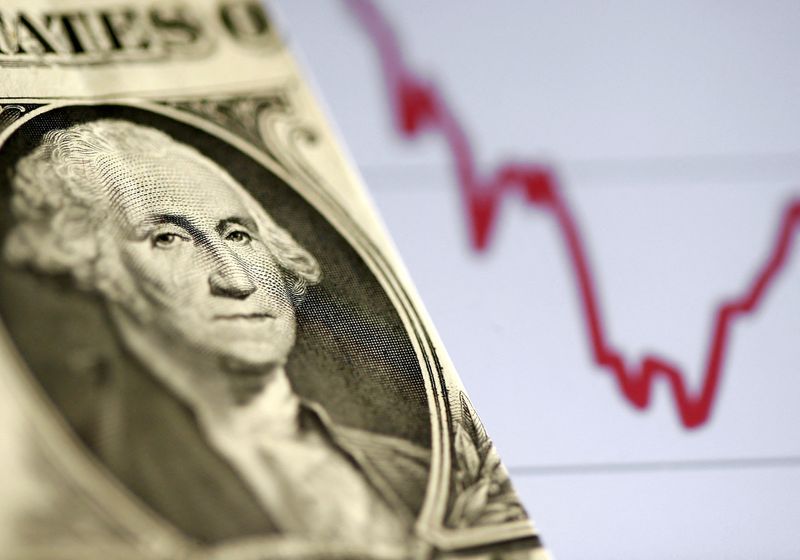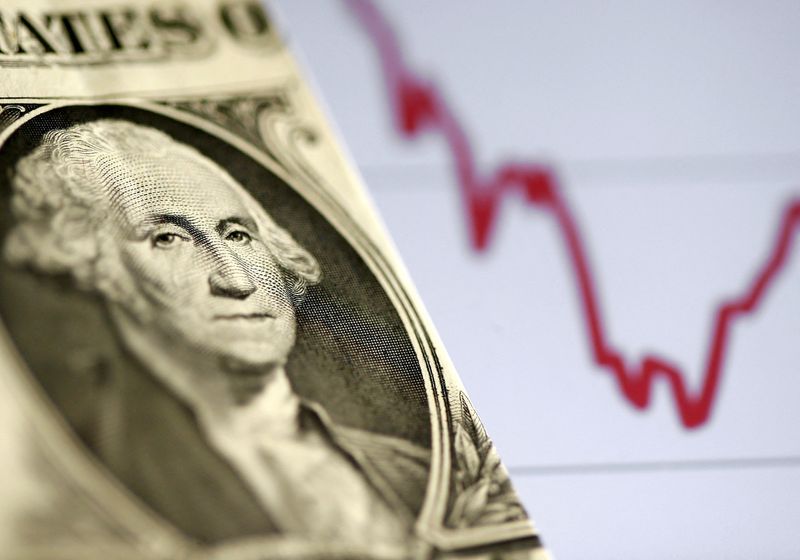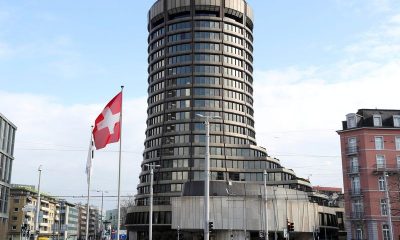Economy
As the Libor era ends, market participants hope for ‘crickets’


© Reuters. FILE PHOTO: A U.S. dollar note is seen in front of a stock graph in this November 7, 2016 picture illustration. REUTERS/Dado Ruvic/Illustration//File Photo
By John McCrank and Gertrude Chavez-Dreyfuss
NEW YORK (Reuters) – The last rates based on the tarnished London Interbank Offer Rate, or Libor, were published on Friday, marking a mostly quiet end of a nearly decade-long effort to move away from what was once dubbed the world’s most important number.
While there has been some scrambling to amend contracts linked to Libor over the past month, the transition was well telegraphed and no major issues are expected, loan and derivatives market participants and lawyers said in interviews.
“I feel like it has been two to three years now that we have been re-papering all the legacy loans and legacy securities we purchased tied to Libor,” said Scott DiMaggio, co-head of fixed income, at Alliance Bernstein.
“We’re pretty comfortable with what we hold,” he said.
Libor, a rate based on quotes from banks on how much it would cost to borrow short-term funds from one another, was first used by a Greek banker in a corner of London’s syndicated loan market in 1969 to help price an $80 million loan for the Shah of Iran.
The benchmark was formalized in 1986 and has been used as a reference rate for a vast array of financial products, including student loans, credit cards, derivatives, corporate loans and mortgages, with over $370 trillion tied to it globally at its peak.
Regulators a decade ago decided to scrap it in favor or more tamper-proof alternatives, such as the Federal Reserve Bank of New York’s Secured Overnight Financing Rate (SOFR), after banks were fined billions of dollars for attempting to manipulate Libor to turn a profit during the 2007-2008 financial crisis.
Friday at 11:55 a.m. British Summer Time (1055 GMT) marked the last publication for the 1-month, 3-month and 6-month U.S.-dollar Libor interest rates. Other U.S. dollar tenors were largely phased out for new contracts at the end of 2021 along with Libor rates linked to other currencies.
Derivatives markets based on Libor had already mostly moved to new benchmarks without major disruption, while some corners of the loan markets, such as syndicated loans, have been busy with contract amendments, market participants said.
“For the most part it’s trending and looking good, but we’re in the risk business so it’s always important to be mindful that there could be some tail effects,” or low probability but potentially disruptive events, said Tal Reback, head of KKR’s global Libor transition effort across private equity, credit, capital markets and real estate.
The number one tail risk for loans that do not smoothly make the transition to another rate is that they could fall back to a more expensive rate, which also poses potential credit risk, she said.
To help minimize disruptions, the U.S. government passed the Libor Act in March 2022. The legislation allows an estimated $16 trillion of “tough legacy” contracts – those that expire after June 2023 and do not have fallback language specifying an alternative rate and thus cannot be amended – to fall back to SOFR, shielding them from related litigation.
Britain’s Financial Conduct Authority also said it would allow the use of a synthetic version of 1-, 3- and 6-month U.S. dollar Libor settings, that are not representative of the outgoing Libor methodology, until September 2024 for tough legacy contracts not covered under the U.S. Libor Act.
Still, there are concerns around the transition similar to ‘Y2K’, the computer coding that was forecast to sow chaos in IT systems worldwide in the early hours of the new millennium on Jan. 1, 2000, said Gennadiy Goldberg, head of U.S. rates strategy, at TD Securities in New York.
“The best case scenario is crickets,” he said.
Economy
Russian central bank says it needs months to make sure CPI falling before rate cuts -RBC


© Reuters. Russian Central Bank Governor Elvira Nabiullina attends a news conference in Moscow, Russia June 14, 2019. REUTERS/Shamil Zhumatov/File Photo
MOSCOW (Reuters) – Russia’s central bank will need two to three months to make sure that inflation is steadily declining before taking any decision on interest rate cuts, the bank’s governor Elvira Nabiullina told RBC media on Sunday.
The central bank raised its key interest rate by 100 basis points to 16% earlier in December, hiking for the fifth consecutive meeting in response to stubborn inflation, and suggested that its tightening cycle was nearly over.
Nabiullina said it was not yet clear when exactly the regulator would start cutting rates, however.
“We really need to make sure that inflation is steadily decreasing, that these are not one-off factors that can affect the rate of price growth in a particular month,” she said.
Nabiullina said the bank was taking into account a wide range of indicators but primarily those that “characterize the stability of inflation”.
“This will take two or three months or more – it depends on how much the wide range of indicators that characterize sustainable inflation declines,” she said.
The bank will next convene to set its benchmark rate on Feb. 16.
The governor also said the bank should have started monetary policy tightening earlier than in July, when it embarked on the rate-hiking cycle.
Economy
China identifies second set of projects in $140 billion spending plan


© Reuters. FILE PHOTO: Workers walk past an under-construction area with completed office towers in the background, in Shenzhen’s Qianhai new district, Guangdong province, China August 25, 2023. REUTERS/David Kirton/File Photo
SHANGHAI (Reuters) – China’s top planning body said on Saturday it had identified a second batch of public investment projects, including flood control and disaster relief programmes, under a bond issuance and investment plan announced in October to boost the economy.
With the latest tranche, China has now earmarked more than 800 billion yuan of its 1 trillion yuan ($140 billion) in additional government bond issuance in the fourth quarter, as it focuses on fiscal steps to shore up the flagging economy.
The National Development and Reform Commission (NDRC) said in a statement on Saturday it had identified 9,600 projects with planned investment of more than 560 billion yuan.
China’s economy, the world’s second largest, is struggling to regain its footing post-COVID-19 as policymakers grapple with tepid consumer demand, weak exports, falling foreign investment and a deepening real estate crisis.
The 1 trillion yuan in additional bond issuance will widen China’s 2023 budget deficit ratio to around 3.8 percent from 3 percent, the state-run Xinhua news agency has said.
“Construction of the projects will improve China’s flood control system, emergency response mechanism and disaster relief capabilities, and better protect people’s lives and property, so it is very significant,” the NDRC said.
The agency said it will coordinate with other government bodies to make sure that funds are allocated speedily for investment and that high standards of quality are maintained in project construction.
($1 = 7.1315 renminbi)
Economy
Russian central bank says it needs months to make sure CPI falling before rate cuts -RBC


© Reuters. Russian Central Bank Governor Elvira Nabiullina attends a news conference in Moscow, Russia June 14, 2019. REUTERS/Shamil Zhumatov/File Photo
MOSCOW (Reuters) – Russia’s central bank will need two to three months to make sure that inflation is steadily declining before taking any decision on interest rate cuts, the bank’s governor Elvira Nabiullina told RBC media on Sunday.
The central bank raised its key interest rate by 100 basis points to 16% earlier in December, hiking for the fifth consecutive meeting in response to stubborn inflation, and suggested that its tightening cycle was nearly over.
Nabiullina said it was not yet clear when exactly the regulator would start cutting rates, however.
“We really need to make sure that inflation is steadily decreasing, that these are not one-off factors that can affect the rate of price growth in a particular month,” she said.
Nabiullina said the bank was taking into account a wide range of indicators but primarily those that “characterize the stability of inflation”.
“This will take two or three months or more – it depends on how much the wide range of indicators that characterize sustainable inflation declines,” she said.
The bank will next convene to set its benchmark rate on Feb. 16.
The governor also said the bank should have started monetary policy tightening earlier than in July, when it embarked on the rate-hiking cycle.

 Forex3 years ago
Forex3 years agoForex Today: the dollar is gaining strength amid gloomy sentiment at the start of the Fed’s week

 Forex3 years ago
Forex3 years agoUnbiased review of Pocket Option broker

 Forex3 years ago
Forex3 years agoDollar to pound sterling exchange rate today: Pound plummeted to its lowest since 1985

 Forex3 years ago
Forex3 years agoHow is the Australian dollar doing today?

 Cryptocurrency3 years ago
Cryptocurrency3 years agoWhat happened in the crypto market – current events today

 World3 years ago
World3 years agoWhy are modern video games an art form?

 Commodities3 years ago
Commodities3 years agoCopper continues to fall in price on expectations of lower demand in China

 Economy3 years ago
Economy3 years agoCrude oil tankers double in price due to EU anti-Russian sanctions



























